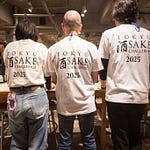Welcome to Issue #61 of SIN.
No April Fools’ Day jokes for us, the world is crazy enough as it is without us throwing anything else into the mix. Instead we're happy to kick back and enjoy the blooming of cherry blossoms that line the streets and brighten the parkways around town. We continue to edge ever closer to the end of the brewing season, and with operating restrictions now lifted from dining and drinking establishments, we hope to see more sake out in the bars and maybe even some tastings and events back on the calendar. Here's hoping…
And now for the news...
What To Do With All That Yamada Nishiki
Hyogo- As the effects of COVID on sake sales continue to drag on; many breweries have been forced to continue reducing production volume. Likewise farmers have reduced plantings of Yamada Nishiki by 20 to 30 percent compared to the previous year. However, despite this decrease in production, there still remains an excess of unused rice. Now more research is being undertaken into the alternative uses for the surplus rice.
One such initiative aimed at increasing Yamada Nishiki consumption, is the Yokawa Town Chamber of Commerce and Industry in Miki City, which developed a pure rice vinegar made from 100% Yamada-Nishiki. Hinode Holding Food Company Tajima Jōzōsho produced the vinegar.
Meanwhile, Hyogo Prefectural University School of Human Science and Environment has been researching alternative uses for Yamada Nishiki. Results have reported the larger grains and suitability for milling to remove out proteins, makes Yamada Nishiki ideal for use in cakes and cookies. The rice flour can be also used as an effective substitute for wheat flour.
Recently a farmer in Miki City collaborated with an Osaka-based confectionery manufacturer to create a baumkuchen (cake) made from 100% Yamada Nishiki. The use of rice instead of wheat makes it perfect for those suffering from gluten allergies. A local bakery in the city has also begun producing bread using Yamada Nishiki rice flour.
One of the researchers, Professor Sakamoto, claimed that based on an analysis of the components of the Yamada Nishiki there is even suggestion that Yamada Nishiki may be easier to digest than other grains. It is hoped further research into the characteristics of processed Yamada Nishiki will lead to the development of more new products.
Source - Kobe NP
JG: Impressive ingenuity! Let’s hope this research shows the benefits of continuing to grow plenty of Yamada Nishiki so that when the demand returns (as we all know it will!) growers can seamlessly support sake brewers again.
Toyama Testing
Toyama- On March 2, a tasting and research event was held by the Toyama Prefecture Brewers Association to assess some of this year's new sake from the region. Submissions came from 17 brewers with a total of 58 sake judged by 10 brewery owners and prefectural Food Research Institute researchers.
The annual event is held to monitor the quality of new sake and to assist in quality control and shipments. This year, 44 ginjō and 14 junmai were put through their paces for the tasters.
Yasutaka Sato, manager of Kanazawa Tax Agency Appraisal Office, said, "temperatures were consistent this year which contributed to a smooth brewing season. There's a lot of aromatic, wonderful tasting sake this year."
The results of the tasting were used as a reference to help determine which sake should be entered in the Kanazawa Regional Taxation Bureau's sake competition, which was held at the end of March, and also the Japan Sake Awards to be held at the end of April.
Source - Hokurikushinkansen-navi
JG: In truth, most prefectures have tastings like this to determine which sake might do well at the “nationals.” But we rarely hear about them.
A Taste Of The Islands
Niigata- Five sake breweries in Sado City have created a collaborative tasting set under the label, Sado Gojō, which allows consumers to compare sake from each brewery. The set was developed through crowdfunding, where the project managed to exceed its funding goal by twenty-fold.
The five Sado breweries involved are: Tenryōhai Shuzō (Tenryōhai), Katō Shuzō (Kintsuru), Henmi Shuzō (Shinryō), Obata Shuzō (Manotsuru), and by Hokusetsu Shuzō (Hokusetsu).
All brewers used the same Sado-grown sake rice, Koshitanrei, however the yeasts, water and brewing methods differed for each brewery. The set is made up of five bottles of junmai ginjō with a common label featuring an image of Sado Island.
According to Ken Hirashima, 57, president of Obata Sake Brewery, which handles public relations for the project, many of the crowdfunding supporters are from outside the island who have tasted sake from one of the five breweries. Hirashima said, "Many were surprised to hear that there are five sake breweries on the island. So, we hope we can continue to promote the charms of Sado to sake fans all over Japan."
According to the Sado Brewer's Association, there were more than 200 sake breweries on the island during the Meiji era (1868-1912), but many went out of business due to difficulties in securing quality sake rice, and an aging population of farmers.
Source - Yomuri
JG: It is cool to hear that the five breweries remaining in Sado Island teamed up for this. But it is astounding to hear that in the Meiji era there were more than 200 kura there!
越淡麗 , 天領盃酒造(天領盃), 加藤酒造(金鶴), 逸見酒造(真稜) , 尾畑酒造 (真野鶴) , 北雪酒造(北雪)
Listen to this episode with a 7-day free trial
Subscribe to Sake Industry News to listen to this post and get 7 days of free access to the full post archives.












